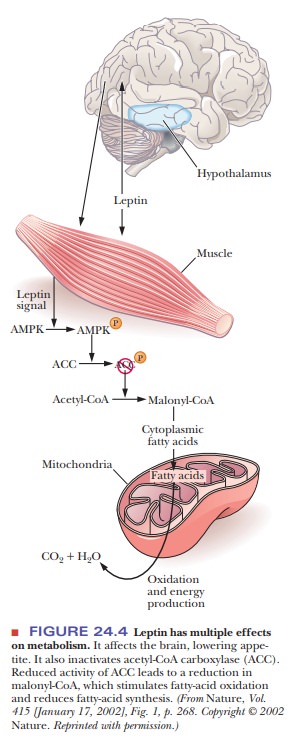Chapter: Biochemistry: Integration of Metabolism: Cellular Signaling
What is obesity?
What is obesity?
Obesity is a major public-health problem in the United States.
Recent figures from the National Institutes of Health show that one-third of
the population is clinically obese, defined as weighing at least 20% more than
their ideal weight. Artificial sweeteners have been introduced, sometimes with
great controversy, to help those who wish to control their weight. Fat
substitutes have come on the market more recently, again accompanied by
controversy. One thing is clear: the topic will continue to be of great
interest, with trade-offs between palatability and health concerns providing a
driving force for finding new products.
The role of the protein leptin in the control of obesity has been
established in mice, and information is just appearing concerning its effect in
humans. It is known that in mice leptin is a 16-kDa protein and that it is
produced by the obesity (ob) gene.
Mutations in this gene lead to a deficiency of leptin, whichin turn leads to
increased appetite and decreased activity, ultimately leading to weight gain.
Injections of this protein into affected mice lead to decreased appetite and
increased activity, with resulting weight loss. Administering leptin to
leptin-deficient humans has been reported to reduce obesity; however, in
clinically obese subjects, the circulating levels of leptin are often high.
Some forms of obesity may be caused by a lack of sensitivity to leptin rather
than a lack of leptin itself.
Leptin stimulates the oxidation of fatty acids and the uptake of
glucose by muscle cells. It does so by stimulating AMP-activated protein
kinase, which phosphorylates an isoform of acetyl-CoA carboxylase (ACC) in
muscle cells, rendering it less active (Figure 24.4). When ACC activity is
decreased, malonyl-CoA levels decrease and the mitochondria can take up and
oxidize fatty acids.

Leptin also inhibits production of the mRNA for hepatic
stearolyl-CoA desatu-rase, an enzyme that adds double bonds to saturated fatty
acids, leading to less lipid synthesis.
Leptin also works directly on the nervous system. Both leptin and insulin are long-term regulators of appetite. They circulate in the blood at concentrations roughly proportional to body-fat mass. They inhibit appetite by inhibiting specific neurons in the hypothalamus. Several laboratories have shown interest in using this information to develop treatments for human obesity.
Related Topics